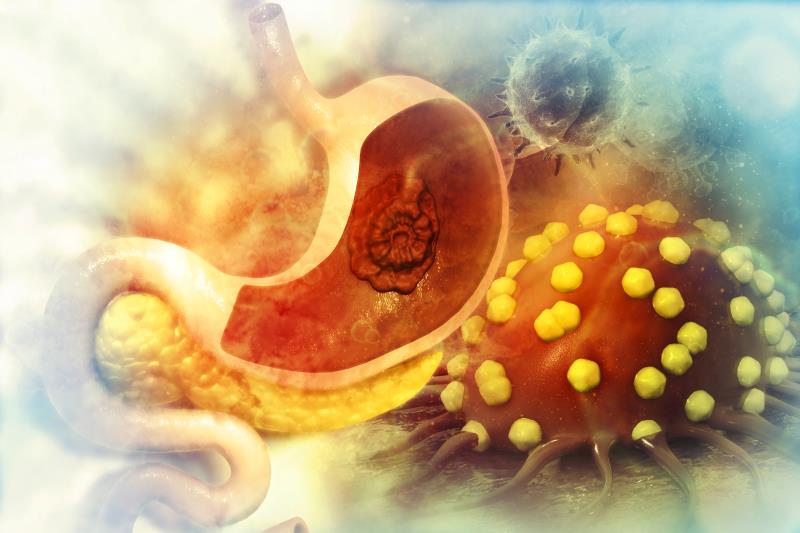
Neoadjuvant chemotherapy with S-1 and oxaliplatin (SOX) may be a suitable treatment measure for patients with advanced gastric or esophagogastric junction adenocarcinoma, according to the RESONANCE* trial presented at ASCO GI 2020.
In this phase III trial conducted at 19 centres in China, 772 patients with advanced (AJCC** stage II–III) gastric or esophagogastric junction adenocarcinoma who were eligible for surgery were randomized 1:1 to the adjuvant chemotherapy group (D2 lymphadenectomy followed by eight cycles of SOX***) or the neoadjuvant chemotherapy group (two to four cycles of SOX followed by D2 lymphadenectomy followed by about eight cycles of SOX). Almost 92 percent of patients in the neoadjuvant chemotherapy group completed all rounds of pre-operative chemotherapy.
Baseline characteristics such as age, sex, and ECOG performance status were well balanced between groups, as were surgical characteristics (eg, duration of surgery, blood loss, type of gastrectomy, number of dissected lymph nodes). However, the R0 resection rate was significantly higher in the neoadjuvant compared with the adjuvant chemotherapy group (94.8 percent vs 83.8 percent).
About 46 percent of neoadjuvant chemotherapy recipients experienced down-staging of disease. Of these, 14.3 percent who were stage III had a complete response (CR), as did 2.1 percent of those with stage II disease. Almost 21 percent with stage III were down-staged to stage I and 1.5 percent down-staged to stage II, while 8.8 percent went from stage II to stage I. [ASCO GI 2020, abstract 280]
In terms of response, 23.6 percent of neoadjuvant chemotherapy recipients experienced CR, 43.9 percent experienced partial response, and 29.7 and 2.8 percent experienced stable and progressive disease, respectively. The total response rate was 67.5 percent, while disease control rate was 97.2 percent.
Postoperative complications occurred at a comparable rate between neoadjuvant and adjuvant chemotherapy recipients. These included grade 3–4 surgical complications such as wound infections (5.7 percent vs 6.1 percent; p=0.833) and anastomotic leak (2.4 percent vs 2.0 percent; p=0.741) and non-surgical complications such as gastrointestinal dysfunction (4.8 percent vs 4.6 percent; p=0.919) and pneumonia (1.4 percent in each group; p=0.955). Postoperative duration of hospitalization was also comparable between groups (11 days in each group). Seventy-two neoadjuvant chemotherapy recipients experienced complications compared with 77 in the adjuvant chemotherapy group (p=0.826).
In a subgroup analysis, R0 resection rates were significantly higher among neoadjuvant compared with adjuvant chemotherapy recipients in patients with stage IIIA, IIIB, and IIIC disease (96.9 percent vs 84.7 percent; p=0.013 [IIIA], 95.9 percent vs 80.0 percent; p=0.010 [IIIB], and 82.5 percent vs 59.6 percent; p=0.018 [IIIC]), with no between-group difference among patients with stage II disease (98.8 percent vs 97.4 percent; p=0.324).
“Peri-operative chemotherapy with standard gastrectomy with D2 lymphadenectomy has [proven to be] superior to surgery alone in local advanced gastric cancer,” said study author Dr Yun Yang from the Chinese PLA General Hospital in Beijing, China, who presented the findings.
However, the treatment regimens vary globally, with perioperative chemotherapy with epirubin, cisplatin, and 5-FU the main strategy used in Europe, and an S-1 or XELOX regimen following gastrectomy and D2 lymphadenectomy used in Asia, said Yang.
The results of RESONANCE show that the SOX regimen is one option of neoadjuvant chemotherapy for locally advanced gastric cancer, with an acceptable adverse effect profile, he pointed out.
He also noted that the survival outcomes of the patients in this trial will be revealed by the end of 2021.